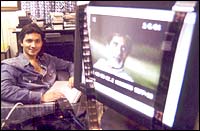
F
arah's diamond is bigger!" Shirish Kunder laughs, as he shows off his diamond engagement ring.The editor of Main Hoon Na, Aankhen, Calcutta Mail, Na Tum Jaano Na Hum, Koi Mere Dil Se Pooche and Armaan got engaged to choreographer turned director Farah Khan in June.
The couple has been dating for seven months now, and hope to get married soon. But the date, Shirish says, is Farah's decision.
The couple had taken off to Goa for a break. And that was when he slipped the ring on her finger.
"We didn't have time to go abroad. So we chose Goa. Goa is a romantic place, isn't it?" he blushes.
The 31-year-old Mangalorean can't recollect the day he got engaged to Farah. "It was a very private thing," he says. "There were only the two of us. We didn't tell anyone because we didn't want others to know about our private lives."
Shirish has known Farah professionally for over four years. They worked closely on Farah's directorial debut Main Hoon Na. But it was not during the shooting in Darjeeling that love knocked on their door. It was when they worked on the film's promos that Farah and Shirish got together.
| |||||||||||
Shirish earned notice in the movie industry when he edited Main Hoon Na and Kamal Haasan's Tamil film, Virumaandi on location.
"I was getting bored sitting in a room, editing the same old stuff. I wanted to try something different. That's when I came up with the idea of editing on location. The only problem was we didn't have the equipment for that," Shirish explains.
That's when his skills and background as an electronic engineer came into play.
Shirish has no formal training in cinema. Yet, he sounds very confident when he talks about films. Editing on location, he says, ensures that there is no wastage of film and time. "Most directors shoot a scene from all possible angles. Then it is up to me to choose the right ones and make it into a proper scene. This happens when a director is not clear about what he wants. But Farah was very clear. The fact that she was a first time director had nothing to do with it. You either have that knack or you don't. Most directors don't have it and keep making the same mistakes over the next 10 years.
"If we had doubts in a couple of places, we would take options. But most directors take options throughout the film! That's why it takes 200 days to shoot a film in India. And we have the worst films being shot for so many days," he says.
 "We are spending enough money but we are shooting crap!"
"We are spending enough money but we are shooting crap!"
Before Shirish entered the film industry in 1997, he worked in Motorola for three years. "I was always inclined towards films. While doing engineering, I also directed plays. But I had no contacts in the industry. After a point, my frustration built up and I could not continue [at Motorola] anymore. I quit and decided to give films a shot."
He started as an assistant editor at Anupam Kher's production house. Shirish gave himself six months to see whether his new career would be as lucrative as the previous one. He tried his hand at scripting, editing and assisting in television serials.
"My main aim was always direction. To become a director, I thought one has to be an editor first. An assistant director does everything like coordination and the legwork for the film, but nothing specific," he explains.
He approached one of the industry's finest editors, the legendary Renu Saluja. "She was editing [Subhash Ghai's] Pardes then. I asked if I could assist her. When she learnt I did not graduate from the FTII, she refused to take me in," he recalls.
Shirish then gave her a copy of a television serial he had edited. After a month, he was a part of her team.
He assisted her on an Italian film, Senso Unico and on Dev Benegal's Spilt Wide Open. It was during the filming of her husband Sudhir Mishra's film Calcutta Mail that Renu succumbed to cancer. That turned out to be Shirish's first film.
"I did not assist her on any commercial film. But all my films have been commercial. So I had no clue how to edit one (a commercial film) in the beginning. But I have no regret of not undergoing formal training in editing. Those who did, did it the conventional way. I always came up with new ways because I didn't have a reference to anything," he says.
 He learnt a lot from Renu. For one, she taught him to be an editor, not an operator.
He learnt a lot from Renu. For one, she taught him to be an editor, not an operator.
"We have only operators in the industry," Shirish says candidly. "I'll tell you the difference. Renu was an editor. I followed her technique. The director gives me a tape of what has to be edited. I make a cut, then show it to him. If he wants to incorporate something more, we do that. What most people do is they sit with the director and the director tells them what he wants and what he doesn't. This person is simply an operator. I take films only on the condition that I edit on my own. I have made mistakes earlier when the director thought I was an operator. I walked out of those films. That's not editing. Anyone can do that."
Doesn't he feel the heat from actors who don't like their scenes being chopped off?
"This generally happens in two or more hero projects. I don't have the authority to refuse actors. That's the director's job. But if the director doesn't [refuse the actor] and if he's okay with screwing his film, I can't help it!"
Shirish is as straightforward as they can get.
"Many of my films have not worked. One comes to know in the first [shooting] schedule whether the film will work or not. If it doesn't work, I usually warn the director. But if they insist on it, I just pass on the film to my assistants to edit, and take my cheque! It's really a waste of time! Most people don't realise that they're making a bad film," he says.
The fact that ultimately the credit for the film's editing goes to him does not bother him.
"That can't be helped. I may do 10 bad films but people will remember that one good one that I did. This goes for all film professions. A R Rahman will give music for one bad film like Lakeer just for the money. Tomorrow, he'll make music for a hit film and everyone will fall at his feet again!
"I did some good editing in Calcutta Mail and Na Tum Jaano Na Hum. But the films didn't work because of a bad script. If the film don't work, it's called a bad film. Initially, you feel bad about it. Then you get used to it," he smiles.
His cynical mood changes when you ask him about Main Hoon Na. "Remember the fist fight in the climax between Shah Rukh Khan and Suniel Shetty? Shah Rukh wanted to do this differently and went through many Hollywood films. He is very technically inclined, so I had this idea," Shirish explains. "If you see the scene carefully, there is no single shot of Shah Rukh actually hitting Suniel. We've done it like a flicker effect. We've taken shots of Shah Rukh's face first, then his fist, and then the fist landing on Suniel's cheek. So it gives the illusion of a fight, whereas they are not actually hitting each other."
 Shirish, who also executed the film's sound design, continues: "In the action sequence at the beginning of the film, there is a shot where Suniel shoots Naseeruddin Shah. There is a lot of noise in the background as the others are shooting at each other. But when Suniel's bullet touches Naseer, I put off all the sound. Then I turned on music, that of a female vocalist. There's an emotional bit where Shah Rukh looks at his father dying. The music heightens the drama. But in the background, everyone is still fighting. Then Shah Rukh sees Suniel running away and starts chasing him. That's when the noise of the bullets comes back, and we get back to reality," he concludes.
Shirish, who also executed the film's sound design, continues: "In the action sequence at the beginning of the film, there is a shot where Suniel shoots Naseeruddin Shah. There is a lot of noise in the background as the others are shooting at each other. But when Suniel's bullet touches Naseer, I put off all the sound. Then I turned on music, that of a female vocalist. There's an emotional bit where Shah Rukh looks at his father dying. The music heightens the drama. But in the background, everyone is still fighting. Then Shah Rukh sees Suniel running away and starts chasing him. That's when the noise of the bullets comes back, and we get back to reality," he concludes.
This is the first film in which he got credit for the sound design. "I've done sound for films like Aankhen too. Before I showed an edited part to the director, I would also incorporate sound effects and the backyard music so that it looked like a final product. Then the director would take it to maybe the music director and say, 'Aise hi kar lo' [Do it like this]."
Besides Main Hoon Na, Shirish also did the promos for Priyadarshan's Hera Pheri. "I didn't do promos for films in between because some were not worth putting in extra effort," he says.
Then he continues excitedly, "I tried a new idea for the promos and after that, other films like Lakshya and Hum Tum started copying us! What we did is, we gave a story hook to the audience. Usually, the makers put the best shots of the film in the promos and show it to the audience. But the audience really has no clue what the story is. I could have done that. A few shots of Shah Rukh Khan would sell a film. But I wanted to try something different. So we showed Shah Rukh looking like a geek going to school. So to the audience, it looks like a budha [an old man] is going to school. Then we changed gears. In the second set of promos, we show him as an army officer on a mission. This makes the audience get involved in the story."







